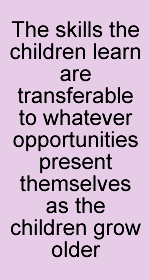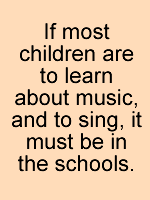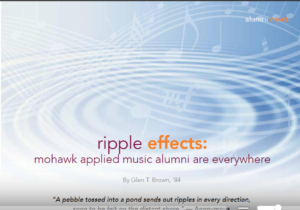by David Fawcett
Each of us lives with music every day. Be it incidentally, as in a grocery store or as an accompaniment to media, or intentionally and purposefully, music is all around us. Not everyone draws or uses arithmetic or even reads every day, but each of us listens to music.
There is a path that can lead everyone to develop a unique personal experience and understanding of music that will stay with us and enrich our lives. That path is through singing, especially in groups or choirs, and it is a path which is best
taken in childhood.
taken in childhood.
At one time, in Hamilton, there were many opportunities for children to sing but these are far rarer now. If most children are to learn about music, and to sing, it must be in the schools.
Unfortunately, educational priorities and changes to scheduling have made it difficult for those interested in this aspect of music education to find time for choirs and singing within the school day.
Here are some very good reasons for administrators to make the difficult compromises needed so that schools can have well conceived and implemented vocal music programs which lend extraordinary short and long term benefits to their students.
To begin with, singing in groups acquaints participants first hand with music that “doesn’t come out of earbuds”. Competent music educators always strive to employ varied music of the highest possible quality. In a choral setting it is possible to use quality repertoire almost immediately. A diverse musical experience is the only way to develop discrimination both as a performer and as a listener. It improves everyone’s life to be able to distinguish between music which is only a product, created to deliver an audience, and music which is more about artistic integrity.
Next, there is the gestalt aspect of group music making, founded in the concept that the whole is greater than the sum of its parts. Choral singers, most not soloists themselves, participate in the recreation of music which is far more complex, and has deeper meaning, than they could possibly make on their own. Again, this benefit can be experienced with the youngest, least skilled singers.This is a big part of what keeps them coming back.
Choral singing in schools also engages children who would not otherwise be involved in group activities, like athletics. It creates an experience of belonging, sometimes for large numbers of kids. It allows children who might not otherwise do very well in school to find something at which they can excel.
Finally, while singing in a choir, even (perhaps especially) as a child, one has the opportunity, repeatedly, to be engaged by the aesthetic experience, that ineffable quality of art that transcends normal life, the thrill of being in the presence of artistic beauty and knowing that one had a part in creating it.
The good news for administrators is that all of this is available at very little cost to the system. A capable teacher, a decent electronic keyboard and a library of materials that grow incrementally, and can be reused, are all that is necessary. No huge initial outlay of capital, no on-going bills for repairs to equipment. The skills the children learn are transferable to whatever opportunities present themselves as the children grow older and move from school to school.
It seems self evident that if you wish people to make authentic connections to ideas or activities it is best done through engaging them directly and actively. For example, those children who play sports, even in an informal way, are far more likely to continue when they are older. Large numbers of them become avid spectators.
 So it is with music. Little children who sing, grow into older children who sing. Adult choristers almost always started to sing as kids. So did most adolescents who excel in middle school music. (Indeed, it would be much more efficient use of resources if all children consistently arrived in middle school band classes having already learned the basics of music making. I never met a child who could not sing in tune and who went on to learn to play an instrument with much success.) Garage bands are full of boys and girls who sang in choirs in school, too.
So it is with music. Little children who sing, grow into older children who sing. Adult choristers almost always started to sing as kids. So did most adolescents who excel in middle school music. (Indeed, it would be much more efficient use of resources if all children consistently arrived in middle school band classes having already learned the basics of music making. I never met a child who could not sing in tune and who went on to learn to play an instrument with much success.) Garage bands are full of boys and girls who sang in choirs in school, too.Thus, music education through singing must be started early, in kindergarten and primary grades. Taught by qualified people who are themselves proficient singers, young children should learn to match pitches and sing appropriate songs with their classmates at a time when they have no prejudice against doing so.
While they proceed through the grades, they continue to sing and build musical skills, as it is an established part of the culture and expectation of their school.
These children transfer their enthusiasm for music and singing to learning a wind or string instrument when the opportunity presents itself.
By the time they arrive at middle school they will have learned the basics of reading music, because they relate to their personal musical experience, not because their teacher needed a written component for report cards.
Only a few of them will take music in high school and fewer yet will study it in college or university.
Yet everyone who receives a quality choral education, even if that person never makes music again, will have established a personal connection, through active participation and experience, that will enhance their life, every day, for their whole life.
©2012 David S. Fawcett
David Fawcett is an Associate of the Canadian Music Centre and a member of the Canadian League of Composers. Now retired, he taught vocal and instrument music at all levels,and conducted for 13 seasons the award winning Buchanan Park Opera Club productions and its chorus on stage and in concerts. His first career was as a classical tenor, performing as a soloist in oratorio and in choral and orchestral concerts, and as a chorister in more than 30 productions with the Canadian Opera Company.
davidsfawcett@gmail.com






